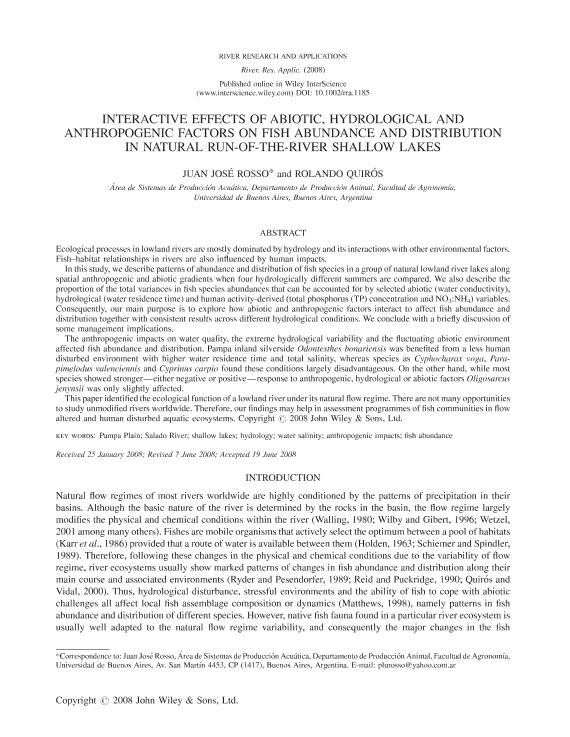Artículo
Interactive effects of abiotic, hydrological and anthropogenic factors on fish abundance and distribution in natural run-of-the-river shallow lakes
Fecha de publicación:
07/2009
Editorial:
John Wiley & Sons Ltd
Revista:
River Research And Applications
ISSN:
1535-1459
Idioma:
Inglés
Tipo de recurso:
Artículo publicado
Clasificación temática:
Resumen
Ecological processes in lowland rivers are mostly dominated by hydrology and its interactions with other environmental factors. Fish–habitat relationships in rivers are also influenced by human impacts. In this study, we describe patterns of abundance and distribution of fish species in a group of natural lowland river lakes along spatial anthropogenic and abiotic gradients when four hydrologically different summers are compared. We also describe the proportion of the total variances in fish species abundances that can be accounted for by selected abiotic (water conductivity), hydrological (water residence time) and human activity‐derived (total phosphorus (TP) concentration and NO3:NH4) variables. Consequently, our main purpose is to explore how abiotic and anthropogenic factors interact to affect fish abundance and distribution together with consistent results across different hydrological conditions. We conclude with a briefly discussion of some management implications. The anthropogenic impacts on water quality, the extreme hydrological variability and the fluctuating abiotic environment affected fish abundance and distribution. Pampa inland silverside Odontesthes bonariensis was benefited from a less human disturbed environment with higher water residence time and total salinity, whereas species as Cyphocharax voga, Parapimelodus valenciennis and Cyprinus carpio found these conditions largely disadvantageous. On the other hand, while most species showed stronger—either negative or positive—response to anthropogenic, hydrological or abiotic factors Oligosarcus jenynsii was only slightly affected. This paper identified the ecological function of a lowland river under its natural flow regime. There are not many opportunities to study unmodified rivers worldwide. Therefore, our findings may help in assessment programmes of fish communities in flow altered and human disturbed aquatic ecosystems.
Archivos asociados
Licencia
Identificadores
Colecciones
Articulos(OCA PQUE. CENTENARIO)
Articulos de OFICINA DE COORDINACION ADMINISTRATIVA PQUE. CENTENARIO
Articulos de OFICINA DE COORDINACION ADMINISTRATIVA PQUE. CENTENARIO
Citación
Rosso, Juan Jose; Quirós, Rolando; Interactive effects of abiotic, hydrological and anthropogenic factors on fish abundance and distribution in natural run-of-the-river shallow lakes; John Wiley & Sons Ltd; River Research And Applications; 25; 6; 7-2009; 713-733
Compartir
Altmétricas




